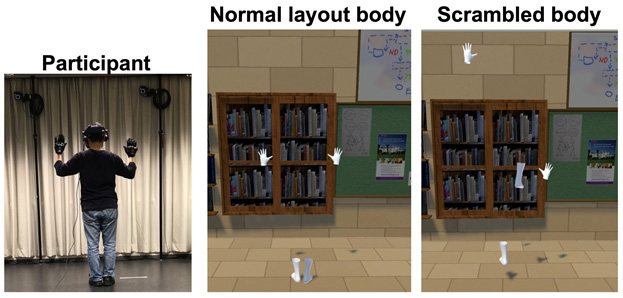
ここからコンテンツです。

Human’s sense of whole body ownership is partly dependent on spatial placement
Separation of body part ownership from body ownership using virtual scrambled body stimulationBy Ryota Kondo
Differences between whole-body and body-part ownership were clarified using scrambled body stimulation in a virtual environment, wherein the hands and feet of the experiment’s participants were presented in randomized spatial arrangements. While moving, the scrambled body stimulation produces a sense of possession of limbs (hands and feet), but possession of the whole body cannot be grasped. Spatial placement is important for the illusion of whole-body ownership. Any individual’s sense of possessing their own bodies can thus be said to be affected by the body’s spatial arrangement.
A research team consisting of Ryota Kondo (Ph.D. candidate), Yamato Tani (Graduate student), and Professor Michiteru Kitazaki from Toyohashi University of Technology, Associate Professor Maki Sugimoto from Keio University, and Professor Masahiko Inami from The University of Tokyo investigated the difference between the sense of ownership of the whole body and the sense of ownership of body parts using scrambled body stimulation. Only the hands and feet of the experiment’s participants were presented, and their spatial arrangement was randomized. It was found that observing the scrambled body stimulus while moving the whole body produces a sense of possession of the body part with respect to the hands and feet, but did not create a sense of possession of the whole body. This result suggests that spatial arrangement is important for the illusion of whole-body ownership. In addition, individual sense of body self-possession may be affected by the spatial arrangement of one’s own body. The results of this study were published in the open access journal Scientific Reports on 24th March 2020.
Whole-body ownership is an important phenomenon to examine bodily self-consciousness. However, differences between our sense of ownership of body parts compared to ownership of the whole body are not completely understood as there has been no effective method to separate these senses of ownership.
Therefore, the research team aimed to develop a method to separate the ownership of body parts from the ownership of whole body. Based on their previous study (Kondo et al., Scientific Reports, 2018) on transparent body stimulation, a scrambled body stimulation that randomly rearranges the positions of hands and feet was conducted. Then, in order to compare it with the stimulus of the same arrangement as the normal body, synchronization with the physical movement was controlled.

In the first experiment, 16 volunteers observed limb-only stimuli from a third-person perspective (2m behind the stimuli) on a head-mounted display. As a result, when vision and physical movement were synchronized, scrambled body stimulation produced only a partial sense of body ownership (It felt as if only the virtual limbs were part of their body), whereas normal placement body stimulation produced both body-part ownership and whole-body ownership (it felt as if the space between the limbs was their body). Similar results were obtained in the second experiment, in which 16 participants observed the stimulus from a first-person perspective.
Thus, humans can feel ownership of certain body parts even if the body parts are scrambled, but cannot get a sense of whole-body ownership in this scenario. However, there was no significant difference in any of the skin conductance response measurement for threat stimuli in the third experiment, conducted with 20 participants.
These results suggest that a spatial placement is necessary for a sense of whole-body ownership, but not necessarily for body-part ownership. Therefore, a person’s whole body consciousness may be impacted by the spatial arrangement of certain body parts. However, the limitation of this study was that there was no difference in skin conductance (physiological) response to a threat stimulus.
Scrambled body stimulation provides a method to systematically examine the sense of ownership of the whole body and body parts. Moreover, it helps explore the limitations of the illusion of how much we can change our body scheme while retaining a feeling of whole-body ownership.
This research was supported by JST ERATO Grant Number JPMJER1701 (Inami JIZAI Body Project), and JSPS KAKENHI Grant Number P19J12660.
Reference
Kondo, R., Tani, Y., Sugimoto, M., Inami, M., and Kitazaki, M. (2020). Scrambled body differentiates body part ownership from the full body illusion. Scientific Reports, 10, DOI: 10.1038/s41598-020-62121-9 www.nature.com/articles/s41598-020-62121-9
全身所有感は身体各部位の所有感の単なる合計ではない
スクランブル身体刺激を用いた全身所有感から身体部位所有感の分離By 近藤 亮太
豊橋技術科学大学と東京大学、慶應義塾大学の研究グループは、バーチャルリアリティ空間でのスクランブル身体刺激を用いて全身所有感と身体部位所有感の違いを明らかにしました。スクランブル身体刺激とは、観察者の手と足のみを提示し、それらの空間的配置をランダムにしたものです。全身を動かしながらスクランブル身体刺激を観察すると手と足に対する身体部位所有感は生じますが、全身所有感を感じることはできず、全身所有感には通常の身体と同様の空間的配置を持つ身体刺激が必要でした。この結果は、全身所有感の錯覚には空間的配置が重要であることを示唆します。また、人の身体的自己意識は、通常の人がもつ身体の空間的配置に影響を受けている可能性があります。
豊橋技術科学大学の大学院生である近藤亮太(日本学術振興会DC特別研究員)と谷大和、研究指導教員の北崎充晃教授、および慶應義塾大学の杉本麻樹准教授、東京大学の稲見昌彦教授による研究グループは、バーチャルリアリティ空間でのスクランブル身体刺激を用いて全身所有感と身体部位所有感の違いを明らかにしました。この研究成果は、2020年3月24日にScientific Reports誌に発表されました。
バーチャルリアリティを用いて、身体運動に同期させてバーチャルな身体の視覚映像を見せることで身体所有感の錯覚を生じさせることができます。研究グループは、2018年5月に手と足のみを提示して身体運動と同期させることで透明な身体を知覚させることができることを示しました(Kondo, et al., Scientific Reports, 2018)。その研究では、バーチャルな手と足に所有感を感じると同時に、それらを補間する身体全体に所有感が感じられました。
全身所有感は、人の身体性自己意識を調べるために重要な現象とされています。しかしながら、身体部位への所有感と身体全体への所有感の違いについては完全には分かっていません。それは、この2つの所有感を分離する良い方法が見つかっていないからです。
そこで、研究グループは、全身所有感から身体部位所有感を分離する方法を開発することを目指しました。彼らの先行研究の透明身体刺激をもとに、手と足の位置をランダムに再配置してしまうスクランブル身体刺激を作成しました。そして、それを通常の身体と同じ配置の刺激と比較する実験を行いました。
最初の実験では、16人の成人が手足のみの刺激をその2m後ろから頭部搭載型ディスプレイで観察しました(三人称視点)。その結果、視覚と身体運動が同期しているとき、スクランブル身体刺激は身体部位所有感のみを生じますが(バーチャルな手足のみが自分の身体の一部であると感じる)、通常配置身体刺激は身体部位所有感と全身所有感(手足の間の空間に透明な全身を感じる)の両方を生じました。一人称視点から刺激を観察した実験でも同様の結果が得られました(実験参加者16名)。つまり、身体をばらばらに分解してランダムに配置しても各身体部位に対する所有感は生じますが、全身を所有している感覚は生じません。ただし、脅威刺激に対する皮膚コンダクタンス反応計測実験については、どの条件の間にも有意な差は見られませんでした(実験参加者20名)。
これらの結果は、身体部位の空間的配置が適切であることが全身所有感に必要ですが、身体部位所有感には必ずしも必要ではないことを示唆します。したがって、人の身体性自己意識は通常の身体部位の空間的配置に制約されている可能性があります。ただし、本研究には、皮膚コンダクタンス反応では差が見られなかったという限界があります。
スクランブル身体刺激は、全身所有感と身体部位所有感について体系的に調べる方法となり得ます。そして、全身所有感の錯覚の限界、つまり人は全身所有感を保持しながらどこまで自らの身体図式を変えることが可能かを調べることに貢献します。
Researcher Profile
ここでコンテンツ終わりです。

